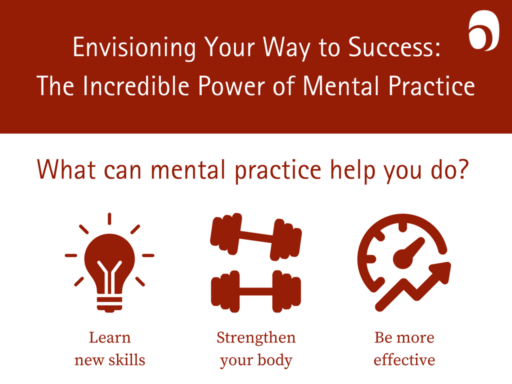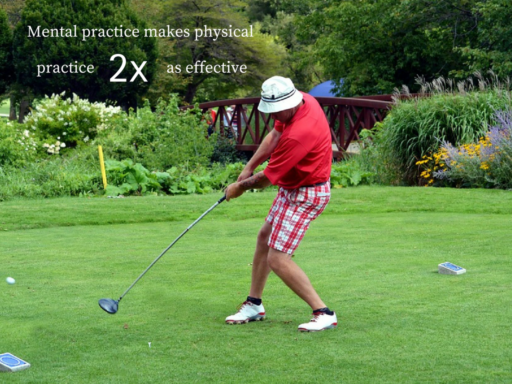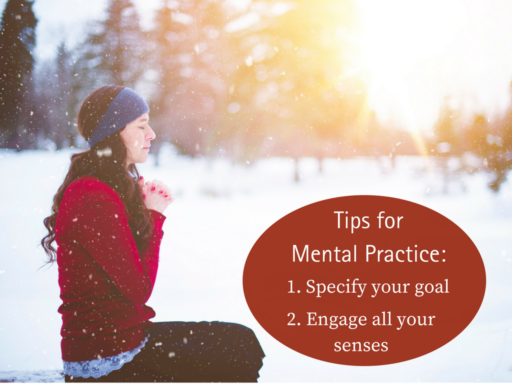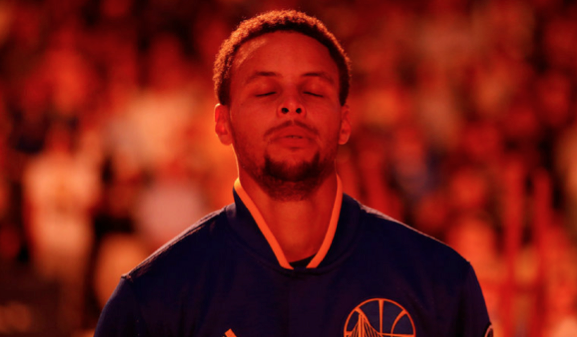How much stronger would you get by sitting on the couch and visualizing your work out? Stronger than you’d think, according to a study done at the Cleveland Clinic, which found that participants could strengthen muscles just by visualizing a physical movement.
And mental practice is good for way more than excusing your lack of trips to the gym lately. We underestimate the value of mental practice, and it’s time that we start taking advantage of its incredible power in multiple areas of our lives, from learning new skills to healing from surgery.
What Is Mental Practice?
Mental practice is the cognitive rehearsal of a physical skill without movement. You visualize or imagine yourself going through the actions, but don’t actually do them. Even though it occurs entirely in your mind, a growing body of evidence shows mental practice can be remarkably effective for learning new skills, improving performance, and even strengthening your body.
Let’s take a look at the incredible research behind these 3 different uses for mental practice, and consider what use it could have in our own lives.

Learn new skills

Strengthen your body

Be more effective
Shhh. I’m Golfing In My Head.
The most common way we hear about mental practice is how it’s used by athletes and musicians. And for good reason – not only have some of the biggest names in sports sung its praises – people like Muhammad Ali, Michael Jordan, and Jack Nicklaus – but there’s a growing body of evidence that for mastering skills, mental practice can be almost as effective as real, physical practice – and that doing both is more effective than doing either alone. Take this study of golfers, which found that novice golfers who combined mental practice with physical practice performed better than those who only did physical practice. Or this study of pianists, which found that mental practice combined with physical practice led to better outcomes than either form of practice by itself.
In fact, researchers have found that a combination of physical practice and mental practice requires half as much physical practice as does physical practice alone to reach the same skill level. Think about that. If you want to master a skill, proper visualizing of your practice can cut your number of actual practice hours in half!
And the same seems to be true not only for acquiring skills, but also for performing them more effectively.



This Is a Funny Question Doc, But….
… have you been visualizing my surgery? You know, like doing it mentally, before we do the real thing?
Because multiple research studies have shown that surgeons who do mental practice before surgery show improved technical ability and enhanced performance. Similarly to athletes and musicians, it’s a combination of mental and physical practice that is most effective for both acquiring and carrying out specific tasks in the operating room.
Wouldn’t you hope your surgeon was doing this sort of mental practice, if it meant better technical skill and improved performance?
But it’s not just surgeons for whom mental practice should be an essential component of preparation. Whether you’re getting ready to give a speech, take part in an important meeting, or talk to your child about something important, there is mounting evidence that mental practice – combined with physical practice – can help you perform better. It reduces anxiety and increases confidence. So any time you know you will be performing a specific task, visualize it beforehand. Imagine not only your words but how you will carry yourself, how you will say those words, and how you will interact with the other people. Make the practice as vivid as possible by tuning in to the sensory experience: what you can see, hear, feel and even smell. It’s about visualizing the process – the specific tasks you will perform. And research shows that the shorter the interval between the mental practice and the performance, the more effective it is.
And what may be most remarkable of all is that mental practice appears to have the power to strengthen and even heal our bodies. So after you see your surgeon – who is hopefully doing his or her mental practice – you owe it to yourself to do yours, too.
And this goes back to the first thing we touched on – that sitting on the couch visualizing your workout is actually way more effective than you’d think it would be.
Little Finger Muscle Builders
In one study, participants strengthened their pinkie fingers through mental practice. No, seriously. In the study, the participants were split up into four groups. The first group performed mental contractions of their pinkie finger. The second group performed mental contractions of their elbows, instead of their pinkie fingers. The third group did physical training to strengthen their pinkie fingers. You know, the traditional way that we all get stronger pinkie fingers. And the final group did no training at all. So who won? Not surprisingly, those who trained physically showed the most improvement, increasing muscle strength by 53%. But those who performed mental contractions of their pinkie fingers improved strength by 35%. Just by visualizing it!
And this study has been replicated in other settings and with other body parts. Guang Yue, an exercise psychologist at the Cleveland Clinic Foundation in Ohio, did an experiment that compared the results of people who went to the gym with those who did a mental workout, completely in their heads. While those who went to the gym increased their muscle strength by 30%, those who did mental visualizations of weight training increased their muscle strength by as much as 13.5%.
Now, for some, this news could deflate their already shaky motivation to go to the gym. So we should switch our focus to research that’s been done in the context of healing from injury – and shows similarly remarkable results.
One study found that stroke victims who engaged in mental practice were more likely to regain movements in limbs that they had lost control of. And another study found that mental practice helped reduce strength loss during short-term muscle immobilization. The possibilities here are really amazing for bringing a more holistic approach to our medical care.
Now if you’re like me, at this point you’re asking yourself:
How is this possible?
Looking Inside the Brain
Our brains have a remarkable ability to imagine. Technological advances, like fMRI scans of the brain, can now look at what brain regions are activated during certain activities – in real time. And what they have found is that visualizing something and actually doing something look remarkably similar in terms of brain activation.
One study of weightlifters found that the same brain patterns that are activated when they lift hundreds of pounds are also activated when they imagine themselves lifting hundreds of pounds. So when you’re visualizing those pinkie exercises, the same region of your brain is activated as when you actually do them. This has been replicated in numerous other contexts. Studies of both pianists and violinists have found similar brain activations during both performances and mental visualizations of performances. Studies of athletes have further confirmed these findings.

The findings are clear: Visualization activates the same motor pathways as actually doing it. It’s activated at a lower level, which is probably why it’s less effective than actual practice, but it’s strengthening those neural pathways nonetheless. Thoughts seem to produce the same mental instructions as actions. They aren’t the same, of course, but there’s a lot of similarity in terms of how your brain is activated by them.
You know what else activates our brains in an almost unbelievable way? What we see other people do. We have cells in our brains called mirror neurons that are triggered both by our actions and others’ actions. They fire when we eat an apple and when we see someone eating an apple – or when we feel fear or see someone else expressing fear. For more on this phenomena, read Are We Wired for Empathy?
An Important Nuance
When it comes to the benefits of mental practice, some research has found that it’s much more effective for experienced people than for novices. This makes sense. Novices may not be familiar enough with the task to construct an accurate visualization of it.
So if you try mental practice and it doesn’t seem to be helping at all, this could be why. For that given skill, you may need to have more physical practice before you can reap the benefits of mental practice.
How to Get Your Mental Practice On
To reap the benefits of mental practice, you first have to ask yourself what you want to do. Do you want to acquire a new skill, or master a skill? Do you want to perform at the highest level? Or do you simply want to heal faster and more effectively?
But regardless of what you want to do, there is a common theme that makes mental practice effective: specificity.
You need to have a specific goal in mind – a specific shot you want to make, a specific outcome from a meeting, a specific way you want to give a speech. Then engage as many of your senses as you can as you do your mental practice. You have to put yourself in the place, with the people, with the objects that you would touch and feel and see as part of normal, physical practice. What does it smell like? How does your body feel? What posture are you in? Who are you with? Do you feel the wind on your face? Or the sweat coming down your cheek? Make this visualization as strong and vibrant and accurate as you can – and you will get the benefits.
Try it out and how let me know how it works in the comments section below!
- Pursue Noble Goals in the Six Seconds Model of EQ - July 29, 2023
- Increase Empathy in the Six Seconds Model of EQ - July 26, 2023
- Exercise Optimism - July 24, 2023


Hi Michael,
I read your article on the sixseconds website titled, “Envisioning your way to success: The Power of mental practice”. It was an excellent article.
My son, Matt is doing an extended essay and his research topic is “Is mental practice more beneficial than physical practice for sportsmen in the week prior to international competition”.
I wanted to know if you had any advice on any articles or people we could speak to in order to gain more insight into this topic.
Your help would be greatly appreciated.
Regards
Neil Wilson and Matt Wilson
I have a hard time visualizing things, I may better at closing my eyes and telling myself things however visualization has always been challenging as I don’t actually see much anything when I close my eyes.
I have used this tool for years and it has work for me over and over I do not think they called it that years ago, but I would visualize what and how I would want to achieve and nine times out of ten my outcome was extremely close to what I had visualized like I said hey call it mental visualization I called it mind over matter but I agree with your findings definitely.
It has been proven that just the act alone of observing an expert performing can create better results than just by practice alone. But it can also set up expectations that will cause you to fail when the situation is different than you anticipated.
Hmm, that is an interesting caveat about the power of mental practice! You can visualize your experience, but if the situation is different than expected, would that cause anxiety and harm performance?
Do you think it’s possible to mentally practice your inner state (breathing, pauses, etc.), and that this could be helpful regardless of the external circumstances? I am not making that argument necessarily, but it seems possible. What do you think?
I am writing this on November 11, 2021. I am a basketball coach. I did my graduate thesis on Mental Practice in 1965. I have used mental practice in many ways. There was one way that had unusual results.
I live in St. Louis. Not a native but temporary move which has lasted longer than I thought.
I would like to talk to you. My phone number is 636-438-8507: email address is [email protected].
Ron Ekker
Mental Reps Visualization Since 1972! Our Bridgeport (WV) Football team won the AAA State Championship in 1972. I used to draw action sketches” of myself making plays in the upcoming game as a DE sacking the QB, making a TFL, blocking a pass etc. Many of those visual mental impressions resulted in those exact drawings becoming real life! Visualization works!
I have been practicing mental rehearsal for some time. It has had a remarkable effect on my surfing especially. I will spend 30 minutes in rehearsal before I hit the surf. I swear by it.
Great article! I have seen some of these research and mostly on improving performance. I have tremor in my hand (may be Parkinson’s?) I find it difficult to visualize healing in my case. Once I begin, it is difficult to be consistent in visualization (as in case of physical movement).
Any suggestions?
Absolutely fabulous article Michael! You’ve presented the science so very well, that I don’t believe it can be denied. As a long-serving NLP practitioner, I absolutely love this informative and transformational practice.
I look forward to reading more of your work.